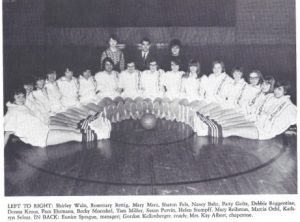When producer Ellie Gordon-Moershel was growing up, she played baseball, tennis, soccer, ice hockey, field hockey, flag football, volleyball, field lacrosse, box lacrosse — basically whatever she could find. If there was a team and a moving object, she was down for it. Ellie’s mom, in her day, had played basketball, but not the 5-on-5 basketball we know today. She played 6-on-6 Iowa girls’ basketball.
 In 6-on-6 basketball the three forwards only play offense. And the three guards only play defense. No one is allowed to leave their assigned half of the court. 6-on-6 still uses the full length of a basketball court, but in a different way than 5-on-5. In 6-player, three forwards from one team and three guards from the opposing team play at one end of the court. Meanwhile their teammates wait at the half court line. This 6-on-6 form of basketball was extremely popular all across Iowa.
In 6-on-6 basketball the three forwards only play offense. And the three guards only play defense. No one is allowed to leave their assigned half of the court. 6-on-6 still uses the full length of a basketball court, but in a different way than 5-on-5. In 6-player, three forwards from one team and three guards from the opposing team play at one end of the court. Meanwhile their teammates wait at the half court line. This 6-on-6 form of basketball was extremely popular all across Iowa.
For a long time Ellie didn’t take 6-on-6 seriously. It didn’t seem like it was “real” basketball. Real basketball — real sports — were what the boys played. Learned childhood experience made it really easy to assume that feminism is just about getting what the boys get. Learning about 6-on-6 illustrated how contrived these sports hierarchies really are. Small town Iowa girls didn’t yearn to play the boys rules, because they already had a culture where girls basketball was valued.
In some places, people saw potential in girls’ basketball and chose to care about it, and chose to put money and maintenance into it. They didn’t expect it to erupt from the soil fully formed. Our sports culture, how inclusive it is, how prestigious, is a collective choice. A choice that Iowa can remind us is all of ours to make.




Leave a Comment
Share